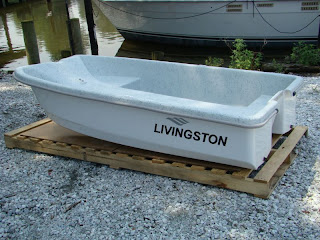We posted this on our Beach House blog and we thought we would share it here since our sailing friends might be interested also.
Cruisers know that the dinghy is the same as the family car when we live ashore.It gets you to shore to buy groceries, visit with friends, and reach those beaches and snorkel spots that can't be reached with the mothership. Ask ten cruisers what the best dinghy is and you will get ten different answers. It will turn out to be one of those discussions like anchoring or cleaning the holding tank. The opinions will fly and the discussion will go on for a long time.
Since we began cruising almost 20 years ago, we wrestled with what type of dinghy would be best for us. After a couple of shake down cruises it became obvious. We first tried a very nice fiberglass skiff that was capable of sailing, with a mast and boom, rowed well and looked very elegant. But in a short time we grew to hate it. We could not carry more than two people and it would only hold a small outboard. It was so tippy getting in and out from the boat that we stopped using it. It was always banging against the hull and dinged everything.
We sold that dinghy and bought an inflatable. Our first inflatable had a soft floor with wooden inserts and standard size tubes. It was a big improvement, more stable, carried more weight and let us up the horse power of the outboard. After our first cruise to the Bahamas, we realized that although better, the design made for a wet ride across the harbor in even a small chop. In Georgetown we had to wear foul weather gear to ride across the harbor on bright sunny days.
It was obvious that we needed an inflatable, we just need a better one. Our next purchase was a RIB from Caribe. It proved to be perfect, it was stable, carried even more weight, used a larger outboard that allowed us to get up on plain, reach our destinations much faster, and with the larger tubes and flared bow, it was a much drier ride.
That dinghy lasted us for ten years and we put a lot of miles on it. It was used and abused all over the Caribbean. It was sold along with our sailboat and the new trawler had an inflatable exactly like our first one only not in as good condition. This was not going to do so the hunt began for a new one. We carried the Caribe on davits on the stern of the sailboat the entire time we owned and cruised the boat. But we did not want to carry a dinghy on the back of the trawler this way, we prefer carrying it on its side on the swim platform. This is doable but not ideal with an inflatable. We had seen a pretty nifty fiberglass dinghy in our travels made by Livingston Boats in Tarboro, North Carolina. We had met a few cruisers with these boats and they really liked them. We started doing research on line and and asking questions of owners and the end results seemed to be that this was a good option for us. The twin hulls gave the stability we needed, the boat would move along quite well with a smaller outboard, which means carrying less weight, it is very well built and it looks really nice. On the website it is referred to as the 8 but is actually 7.5 feet.
There is also a mounting option for dinghy mounting brackets made by Weaver Davits that would make mounting on the swim platform easy and secure. It also makes launching and retrieval easy, which is very important to us. It took at the most a couple of hours to install the Weaver Davits and have the boat resting on the swim platform. We just love it when a plan comes together.
Subscribe to:
Post Comments (Atom)














No comments:
Post a Comment
Note: Only a member of this blog may post a comment.